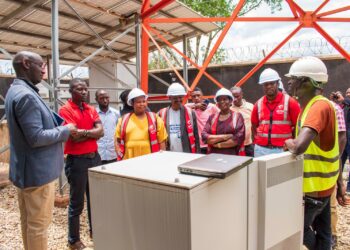By THE NEW YORK TIMES
A wall is going up in the desert of Egypt near the border of the war-torn Gaza Strip, but no one is talking much about it.
Satellite imagery, photographs and video analyzed by The New York Times show a large patch of land being bulldozed and the wall being built in the buffer zone between Egypt and Rafah, the southern Gaza city overflowing with over a million displaced Palestinians that Israeli forces are poised to invade.
The satellite imagery clearly shows newly graded land south of the Rafah border crossing. An analysis of the satellite images indicated that the work began around Feb. 5.
But the Egyptian government, which has looked on with concern as Gazans displaced by the war between Israel and Hamas mass in Rafah, has declined to discuss the new construction. A spokesman for the government would only refer to statements by the government in recent weeks highlighting its fortification of the border.
It was not clear whether the structure might be intended to hold Gazans who crossed the border, but if it were to be used that way, it would be a major reversal of Egypt’s stance.
A contractor and an engineer who were interviewed by The Times and provided photos said they had been commissioned by the Egyptian Army to build a five-meter-high concrete wall — about 16 feet — to close off a five-square-kilometer plot of land at the site. They said they had begun work on Feb. 5 and started on the wall two days ago.
The contractor and the engineer spoke on the condition of anonymity, saying that they feared reprisals. The Egyptian authorities heavily restrict information coming from the border area.
Since October, when a Hamas-led attack on Israel led to immense Israeli military retaliation in Gaza, Egypt has repeatedly rebuffed any suggestion that it take in some of the Gazans who have fled air and ground assaults to areas near the border in Rafah. Egyptian officials fear that an influx of refugees would pose a security risk, and many Palestinians suspect that Israel might not allow people who leave Gaza to come back when the war is over.
In recent weeks, uprooted Gazans have crammed into Rafah, on the border of Egypt, struggling to survive in tents and makeshift shelters with scarce access to food and other critically needed supplies, aid workers say. One Gazan official in Rafah, Ahmed al-Soufi, estimated that there were over 100,000 displaced Palestinians in encampments pressed against the border.
At a meeting convened by Egypt on Thursday, Martin Griffiths, the United Nation’s top aid chief, said that “the possibility of spillover, a sort of Egyptian nightmare, is one that is right before our eyes.”
Like Israel, Egypt has sealed its borders with Gaza, and in recent months it has been adding fortifications to its border area.
A day after the Oct. 7 Hamas-led attack on Israel, the governorate of North Sinai — where the work captured in the satellite images is taking place — said in a statement that the governor had held an emergency meeting with senior local officials to “study the capacities of schools, housing units and empty land that can be used as shelter sites if necessary.”
But on Thursday, the deputy governor of North Sinai, Maj. Gen Hisham el-Khouly, said he was not aware of any new construction. And the governor of North Sinai, Maj. Gen Mohamed Shousha, did not respond to phone calls seeking comment.
Ahmed Ezzat, the head of emergency operations at the Egyptian Red Crescent, which coordinates Gaza-related humanitarian assistance work at the border, said he had not heard of the project.
Nick Cumming-Bruce contributed reporting from Geneva, and Adam Rasgon from Jerusalem.







Discussion about this post